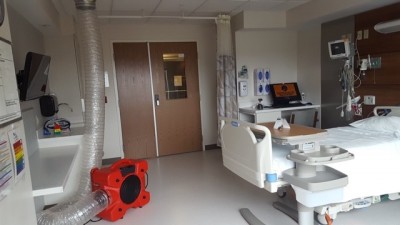
- WHOLE HOUSE AIR PURIFIER – AS-550 HEPA air purifiers remove harmful airborne particles including asbestos, mold spores, mildew, smoke, pet dander, pollen, saw dust, and other miscellaneous debris
- HEAVY DUTY – The pre-filter protects the prime HEPA filter acting as a large particle cleaner allowing the HEPA filter to do the finer work. Ideal for home repair and construction sites, mold and sewage remediation, water and fire damage restoration
- PRECISION – HEPA filters are standardized to remove 99.97% of particles that have a size greater than or equal to 0.3 micrometers. Perfect for purifying the air from allergens in a hospital room or children’s bedrooms
- ODOR ELIMINATOR – The optional carbon filter (Not Included) eliminates odors from paint, smoke, pets, cleaning products, cooking, etc. This separately sold filter is perfect for a salon or print shop for removing unwanted fumes
- WARRANTY – 1-year and 5-year housing warranty. Our Air Shield 550 is engineered with roto-mold technology into a single housing piece making it the toughest in the market. We stand by our quality products and hope you do too
Cleaning and Disinfection for Community Facilities
Interim Recommendations for U.S. Community Facilities with Suspected/Confirmed Coronavirus Disease 2019 (COVID-19)
There is much to learn about the novel coronavirus (SARS-CoV-2) that causes coronavirus disease 2019 (COVID-19). Based on what is currently known about the virus and about similar coronaviruses that cause SARS and MERS, spread from person-to-person happens most frequently among close contacts (within about 6 feet). This type of transmission occurs via respiratory droplets, but disease transmission via infectious aerosols is currently uncertain. Transmission of SARS-CoV-2 to persons from surfaces contaminated with the virus has not been documented. Transmission of coronavirus in general occurs much more commonly through respiratory droplets than through fomites. Current evidence suggests that SARS-CoV-2 may remain viable for hours to days on surfaces made from a variety of materials. Cleaning of visibly dirty surfaces followed by disinfection is a best practice measure for prevention of COVID-19 and other viral respiratory illnesses in community settings.
It is unknown how long the air inside a room occupied by someone with confirmed COVID-19 remains potentially infectious. Facilities will need to consider factors such as the size of the room and the ventilation system design (including flowrate [air changes per hour] and location of supply and exhaust vents) when deciding how long to close off rooms or areas used by ill persons before beginning disinfection. Taking measures to improve ventilation in an area or room where someone was ill or suspected to be ill with COVID-19 will help shorten the time it takes respiratory droplets to be removed from the air.
